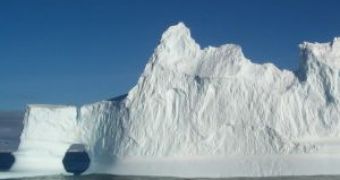A team of scientists led by Professors Douglas MacAyeal at the University of Chicago and Emile Okal at Northwestern University has presented evidence that a huge storm that occurred in the Gulf of Alaska in last October generated an ocean wave that six days later broke apart a giant iceberg floating near the coast of Antarctica, more than 8,300 (13,500 km) miles away. "We are reporting on a unique kind of seismological signal picked up by seismometers we deployed on the iceberg, which is generated by sea swell when it rocks the iceberg," said Okal, professor in geological sciences.
Oceanographers observed in the early 1960s that ocean swells can travel half way around the world. This is a proof that storms driven by climate change could affect parts of the globe situated faraway from the place of their occurrence. "Could global storminess have an influence on the Antarctic ice sheet that had never been thought of?" said MacAyeal, professor in geophysical sciences.
Daily satellite images generated by researchers at the University of Wisconsin, Madison, showed that on a clear, calm day last Oct. 27, iceberg B15A, 60 miles long x 18.5 miles wide) broke into half a dozen pieces. It was half of B15, the world's largest iceberg in March 2000 when formed from the Ross Ice Shelf (Antarctica).
Since then, scientists had planted seismometers on B15A and on Antarctica's Ross Ice Shelf to study "iceberg songs" and related phenomena. "We are trying to figure out how the icebergs are sort of making music when various phenomena that we think are linked to the cracking of iceberg masses takes place." Okal said.
The seismometer recovered from B 15 A recorded movement in the iceberg starting 12 hours before the iceberg broke up and continuing for three following days. The iceberg moved half an inch up and down and four inches from side to side, even if the weather was calm, so the team suspected ocean swell as the cause. "It's been known for a long time that swell can travel," Okal said.
"If you have a seismometer on an island, the swell will hit the island and it will contribute to the noise of a seismometer. It plagues our seismic recording on island stations."
The islands respond to swell at a much smaller amplitude than the recording from team's seismometer. "I was surprised at the level of amplitude that we were recording," Okal said.
The team knew there must have been a storm somewhere to create the swell and could calculate the distance. "We looked in the Pacific Ocean and there, 13,500 kilometers away, six days earlier, was the winter season's first really big, nasty storm that developed and lasted for about a day and a half in the Gulf of Alaska."
"We looked at the wave-buoy records in Hawaii and Alaska. We saw that the waves in Alaska were about 35 feet tall and then two days later they were down to 15 feet as they passed Hawaii on their way south," MacAyeal said.
Three days later, a seismometer on Pitcairn Island (South Pacific) recorded the passage of the storm waves. "Finally, we see the waves arriving in Antarctica at the site where the iceberg broke up and at several other sites in Antarctica," he said.
"We think that B15A was in the right position where these waves would be fatal to it," MacAyeal said. "The iceberg shattered like a gracile wine glass being sung to by a heavy soprano."
These occurrences appear to be common. Scientists also detected other distant storms in Antarctic seismometer records. "The most impressive event was a typhoon in the Pacific that had been a category five hurricane called Olaf. It produced a very strong reaction on all of our seismometers, so we know that hurricanes do send their waves down to the Antarctic as well," he said.
Distant storms in both the Northern and Southern Hemispheres correlated with all 38 seismological events recorded on their seismometers from December 2004 to March 2005. This finding helps to explain some tricky paleoclimatic evidence from the north Atlantic. Between 15,000 and 80,000 years ago, the region looked much like Antarctica today. Researchers found layers of ice-rafted debris in ocean-floor sediments. "The deep-sea sediments show that icebergs coming from all around the edge of the north Atlantic calved all at once," MacAyeal said.
"If calving is sensitive to ocean storminess and to ocean waves, then we have a common cause for iceberg calving around the entire periphery of the north Atlantic," he said.
The discovery came as a warning about the impact of the global warming in the intensification of melting on the Arctic and Antarctic ice.

 14 DAY TRIAL //
14 DAY TRIAL //